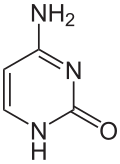DNA methylation

DNA methylation is the main way gene activity is adjusted during life, especially during early development.[1]
It is how methyl groups are added to DNA. This suppresses gene transcription. Two of DNA's four nucleotides, cytosine and adenine, can be methylated. Since adenine methylation is restricted to prokaryotes, all eukaryote transcription is regulated by suppressing cytosine.[1][2]
Suppressing genes is the basis of epigenetics, the study of changes in gene activity which are not caused by changes in the DNA sequence.[3] It is the study of gene expression, the way genes bring about their phenotypic effects.[4]
The changes in gene activity by methylation may last for the rest of the cell's life, and for many generations of cells through cell divisions. However, there is no change in the underlying DNA sequence of the organism. Instead, non-hereditary factors cause the organism's genes to behave (express themselves) differently.[1][5]
- To give just one example of how important this is, think about the effect nutrition of a pregnant female has on the baby long after birth.[6]
DNA Methylation Media
References
- ↑ 1.0 1.1 1.2 Law, Julie A. & Jacobsen S.E. 2012. Establishing, maintaining and modifying DNA methylation patterns in plants and animals. Nature Reviews in Genetics 11 (3) 204–220. [1]
- ↑ Carey, Nessa 2011. The epigenetics revolution: how modern biology is rewriting our understanding of genetics, disease and inheritance. London: Icon Books. ISBN 978-184831347-7
- ↑ By "DNA sequence" we mean the sequence of nucleotide base pairs in an exon, which is the part of a gene which determines the sequence of amino acids in the coded protein.
- ↑ King R.C. Stansfield W.D. & Mulligan P.K. 2006. A dictionary of genetics, 7th ed. Oxford. p146
- ↑ Bird A. (2007. Perceptions of epigenetics. Nature 447 (7143): 396–8. [2]
- ↑ Carey, p93








